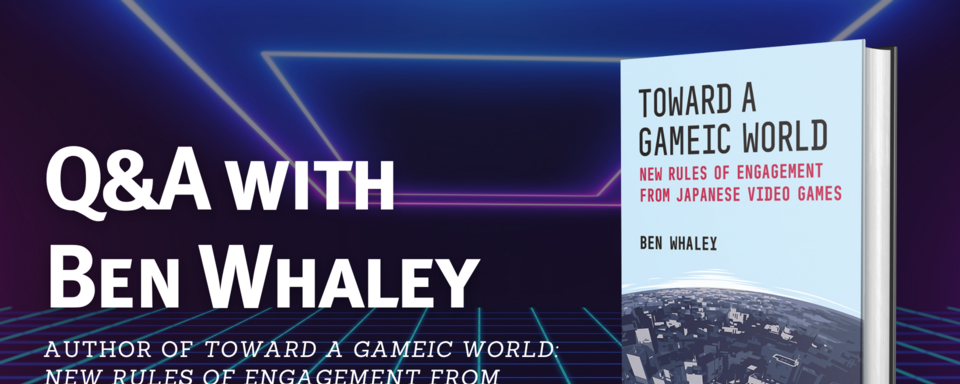Q&A with Ben Whaley

This guest author post is a Q&A with Ben Whaley, author of Toward a Gameic World: New Rules of Engagement from Japanese Video Games , from the University of Michigan Press. The book is Volume 100 in the Michigan Monograph Series in Japanese Studies and is available in hardcover, paper, and accessible ebook.
What originally interested you in Japanese video games?
I have played video games ever since I was young and owned most of the major home console systems. However, growing up, I am not sure that I associated many of the Nintendo, Sega, and Sony games I played with Japan per se. One of my earliest influential memories with Japanese games came when I first played PaRappa the Rapper (NanaOn-Sha, 1996) for the original Sony PlayStation. It was unlike any game I had ever played before. The quirky raps of composer-designer Matsuura Masaya, the plucky, “paper-thin,” two-dimensional character designs of American visual artist Rodney Alan Greenblat, and the then-novel pattern repetition gameplay came together to create a visual and sonic experience that remains one of my favorites even to this day. It was probably from playing PaRappa that I first came to appreciate how inventive and engaging Japanese video game design could be.
Toward a Gameic World examines the games Disaster Report, Catherine, Metal Gear Solid V, and The World Ends with You - how did you select these games?
The book as a whole was largely inspired by the game Catherine (Atlus, 2011) - a full discussion of which appears in chapter two. While first playing, I became very interested in the ways in which this seemingly mundane puzzle game told a much larger grand narrative about the politics of intimacy and infidelity in contemporary Japan, and paired this thematic focus with a gameplay polling mechanism that sought to elicit players’ own real-world self-reflection from within the simulation. With each case study examined in the
book, I sought to similarly select a game that not only had something profound to say about social anxieties and traumatic events in Japan, but that also tackled these issues using innovative gameplay approaches to more strongly engage players.
Photo from Catherine website.
As you researched and wrote the book, what surprised you the most?
Building on the previous answer, one of the things that surprised me the most was how the games in this book that grapple with social anxieties, trauma, and Japanese cultural issues, do so as mass-market, commercially-available games for a wide audience. While there are no doubt many small scale or independent games that touch on similar issues, it surprised me how willing commercial developers were to involve players in these difficult simulations. Also, the more I began tracing out the four new rules of engagement I discuss in the book–“limited,” “distanced,” “external,” and “connective”– the more I began to see these factors at play in a variety of others games I didn’t have the space or time to discuss. So, it definitely seems that Japanese designers and development teams do enjoy deploying and playing with these strategies on a broad scale.
What can video games tell us about culture and social issues?
Much like other pop cultural media from Japan, such as manga (print comics) or anime (animation), video games can certainly serve as useful reflections of the country, culture, or auteur from which they came. However, video games do not simply hold a mirror up to these cultural and social issues. Rather, one of the points I make in the book is that the new rules of engagement have the capacity to evoke actual feelings of overcoming, guilt, complicity, or shared connection in players from a fictional experience of trauma. In doing so, many of these Japanese games open up imaginative alternate worlds from which players can plan, revise, and rehearse their responses to life’s many problems, including those that may never affect them directly.
What do you hope readers will take away from reading Toward a Gameic World?
Photo of author Ben Whaley playing video games as a kid.
I hope readers will come away from Toward a Gameic World thinking a bit more deeply about the video games they play, not simply for their narratives or characters, but in terms of how they might inspire and motivate us as players to engage with complex issues. Japanese designers have shown us some of the ways that they devise fun and novel strategies to affectively engage with these oftentimes difficult themes. In this sense, I hope readers can also appreciate how video games can function as a beneficial tool for thinking about social issues and the human condition–a tool that can have profoundly positive effects on who we are as people. Japanese video games have evolved alongside manga and anime for a large part of their shared history, yet some readers may still not play games regularly themselves nor read many academic studies like Toward a Gameic World. I hope these readers might pick up one, or all, of the games discussed in the book and give them a play!





